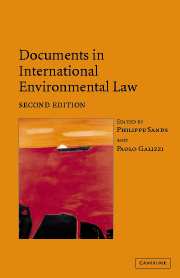Book contents
- Frontmatter
- Contents
- Preface
- PART I General instruments
- PART II Atmosphere
- 5 Convention on Long-Range Transboundary Air Pollution, 13 November 1979
- 5A Protocol to the 1979 Convention on Long-Range Transboundary Air Pollution on Further Reduction of Sulphur Emissions, 14 June 1994
- 5B Non-Compliance Procedure
- 6 Convention for the Protection of the Ozone Layer, 22 March 1985
- 6A Montreal Protocol on Substances that Deplete the Ozone Layer, 16 September 1987
- 6B Non-Compliance Procedure
- 7 United Nations Framework Convention on Climate Change, 9 May 1992
- 7A Kyoto Protocol to the United Nations Framework Convention on Climate Change, 11 December 1997
- 7B Marrakech Accords (extracts)
- PART III Oceans: global
- PART IIIB Oceans: regional
- PART IV Freshwater resources
- PART V Biodiversity
- PART VIA Hazardous substances and activities: nuclear
- PART VIB Hazardous substances and activities: pesticides
- PART VIC Hazardous substances and activities: waste
- PART VII Human rights and the environment
- PART VIII War and the environment
- PART IX Trade and the environment
- PART X Environmental impact assessment and access to information
- PART XI Liability for environmental damage and breaches of environmental obligations
- PART XII The Antarctic
6 - Convention for the Protection of the Ozone Layer, 22 March 1985
Published online by Cambridge University Press: 05 June 2012
- Frontmatter
- Contents
- Preface
- PART I General instruments
- PART II Atmosphere
- 5 Convention on Long-Range Transboundary Air Pollution, 13 November 1979
- 5A Protocol to the 1979 Convention on Long-Range Transboundary Air Pollution on Further Reduction of Sulphur Emissions, 14 June 1994
- 5B Non-Compliance Procedure
- 6 Convention for the Protection of the Ozone Layer, 22 March 1985
- 6A Montreal Protocol on Substances that Deplete the Ozone Layer, 16 September 1987
- 6B Non-Compliance Procedure
- 7 United Nations Framework Convention on Climate Change, 9 May 1992
- 7A Kyoto Protocol to the United Nations Framework Convention on Climate Change, 11 December 1997
- 7B Marrakech Accords (extracts)
- PART III Oceans: global
- PART IIIB Oceans: regional
- PART IV Freshwater resources
- PART V Biodiversity
- PART VIA Hazardous substances and activities: nuclear
- PART VIB Hazardous substances and activities: pesticides
- PART VIC Hazardous substances and activities: waste
- PART VII Human rights and the environment
- PART VIII War and the environment
- PART IX Trade and the environment
- PART X Environmental impact assessment and access to information
- PART XI Liability for environmental damage and breaches of environmental obligations
- PART XII The Antarctic
Summary
Editorial note
The Vienna Convention for the Protection of the Ozone Layer, negotiated under the auspices of UNEP, is intended to protect humans and the environment from the harmful effects of activities which modify the ozone layer (Article 2(1)). To achieve this end, the Convention requires Parties to cooperate, according to their means, in research and legislative measures (Article 2(2)(a) and (b)) and to formulate agreed standards, procedures and measures in the form of Protocols and Annexes (Article 2(2)(c)). Parties are also required to facilitate the exchange of relevant ‘scientific, technical, socioeconomic commercial and legal’ information (Article 4(1)), as set out in Annex II. A further obligation is to facilitate exchange of technology, subject to relevant national law (Article 4(2)). Parties are required to report on the measures taken to implement the Convention and Protocols (Article 5). The Convention establishes a Conference of the Parties which meets on a regular basis to review the Convention (Article 6). UNEP provides Secretariat functions, including the co-ordination of meetings and reports to the Conference of the Parties (Article 7). If a dispute arises between the Parties, the Convention provides several methods of dispute resolution, including: (a) mediation at the request of the Parties involved (Article 11(2)); (b) voluntary submission to arbitration and/or to the ICJ (Article 11(3)); (c) the submission of the dispute to a conciliation body (Article 11(4)).
- Type
- Chapter
- Information
- Documents in International Environmental Law , pp. 63 - 81Publisher: Cambridge University PressPrint publication year: 2004



